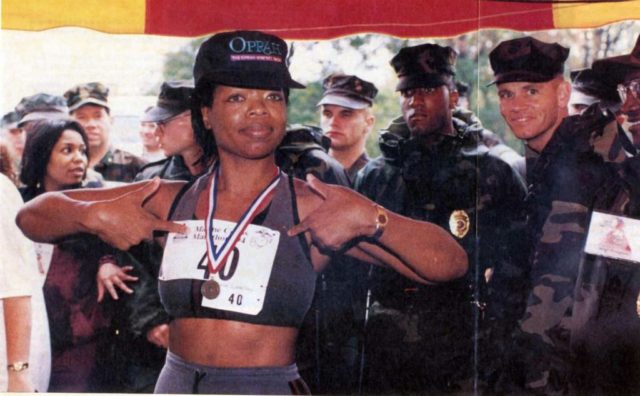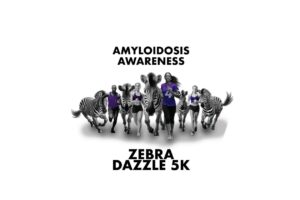
In October 1994, on a chilly, rainy day, I toed the line for my first marathon after five months of haphazard training. I had three goals: finish the Marine Corps Marathon in less than four hours, not walk a single step, and beat Oprah!
The world learned days before that the queen of day-time television, Oprah Winfrey, was also attempting her first go at the distance. Surely if Oprah could run a marathon, then so could I!
Everything I knew about the marathon I learned from a book I found on running and from my trusted training partner whose one marathon made her the expert in my eyes.
Our training plan was simple: run on your own a “few” days during the week and then meet up on Saturday mornings for long runs. We’d do many of these runs on the C&O Canal Towpath and the distance would increase each week, culminating in an 18-miler to Union Station from Bethesda.
I was so naïve; there were so many lessons learned that day. Example: that a cotton shirt combined with rain and sweat contributes to significant blood loss and a very painful post-race shower. That running at half marathon pace for the first half of the race is not a wise pacing strategy.
Who needs to drink water when it’s raining out? Why would anyone want to eat a PowerBar while they are running? Who knew that clipping toe nails before the race would help prevent them from falling off? (Speaking of toes, who has ever heard of black toe nails anyway? And, why wasn’t I warned about the perils of cotton socks?)
I could go on and on, but the memories — and the therapy to put it behind me — are too painful.
Despite the inevitable early slam into “the wall” — somewhere around mile 18 — I did manage to stubbornly run every step of that race. I finished in 3:59:17: to this day a personal worst, but under four hours. I also managed to beat Oprah by a half-hour, passing her and her team of comically overdeveloped bodyguards somewhere around mile five. She finished in a very respectable 4:29:15.
But, once Oprah became a marathoner, something far bigger happened. She started a movement — literally — for tens of thousands of people! And the catch-phrase: “Beat Oprah” was born. When word spread on radio, television and the papers that Oprah had finished a marathon, the world wanted to know just how she did it.
In a four-and-a-half-hour instant, Oprah had dismissed the notion classifying marathon runners as physically-gifted, thrill-seeking, crazy extremists and opened up the sport to a whole new class of wannabe athletes. If Oprah could lose 70 pounds and train for a marathon, then anyone could do the same. This one woman literally changed the perception of marathon running. No longer does a runner need to come in first to “win.” Just like that, the second bouncing baby running boom was born, thanks to a wildly popular talk-show host who just aspired to finish.
The tide changed, and all of the sudden, so did marathon running. Do we have Oprah to thank for this running boom? Maybe, maybe not. Either way, it really doesn’t matter. All that matters is that people are active and running. For some folks, it’s a bucket-list item. For others, it’s a lifestyle change.
To the purists, however, Oprah didn’t do the marathon mystique any favors. During the first running boom in the late 1970s and early 1980s we were inspired by the likes of Bill Rodgers, Alberto Salazar and Frank Shorter, who clearly dominated the sport of marathoning. The goal for most runners was simply to qualify for the Boston Marathon. The average finish time for male marathon finishers in 1980 was 3:32. In 2013, it was 4:16.
With Oprah’s achievement, the mythical goal of qualifying for Boston was tossed out like a pair of worn racing flats. Beating Oprah was now the new acceptable benchmark for runners — attainable for most. It was now perfectly okay if you didn’t qualify for Boston as long as you beat Oprah. Thus, some would say Oprah actually lowered the bar and made it okay to walk or merely finish a race. Running fast was secondary. The focus was more on being healthy and just covering 26.2 miles before they closed the course.
Clearly, the demographics for marathon runners have changed. In the ’80s, marathon runners were known as elite athletes — typically 90 percent male. In 1995, that ratio had dropped to three male runners for every woman. Today, men only slightly outnumber women at the marathon distance, but the median age for women is nearly five years younger than men, and it continues to trend lower. And, the number of races is also exploding.
In 2013, there was a record 1,100-plus U.S. marathons compared to approximately 300 marathons in 2000, according to Running USA. In 1994, 12,675 runners finished MCM. The number of finishers increased by about 15 percent in 1995 and has been steadily increasing ever since. For this year’s running of MCM the field is 30,000. Nearly all of these runners registered for a lottery and the race filled within days of registration opening–a typical occurrence for most large marathons in the U.S. The 500,000th MCM finisher will cross the finish line this year.
Say what you will about the consequences of Oprah’s marathon finish in 1994, but there’s no denying that marathon running is here to stay. As a certified running coach for the Montgomery County Road Runners Club in Maryland, I have personally worked with scores of runners who — through perseverance, drive and discipline — conquer the marathon distance and beyond. The resources — including access to training groups and clubs — available to runners today are astounding. So whether you’re gunning for a Boston Marathon qualifier or you’re a first time marathoner just trying to beat Oprah, the time has never been better to give it your best shot.
This article was originally published in the November/December 2014 issue of RunWashington.
Recent Stories
Looking for our race calendar? Click here Submit races here or shop local for running gear
Zebra Dazzle 5k Walk/Run or 100 Bike over 30 Days
Join the Zebras for this Zebra Dazzle event for all fitness levels. The 5k Walk/Run has 2 options. You can participate as an onsite participant on 9/13 at Carter Barron in Rock Creek Park, NW Washington DC or as a
Hero Dogs 5K9
Hero Dogs Inc will host its 5th Annual 5K9 race at the Congressional Cemetery on Saturday, May 17th, beginning at 8 am. There will also be a 1K Fun Run. The 1K Fun Run will start at 8 am sharp






